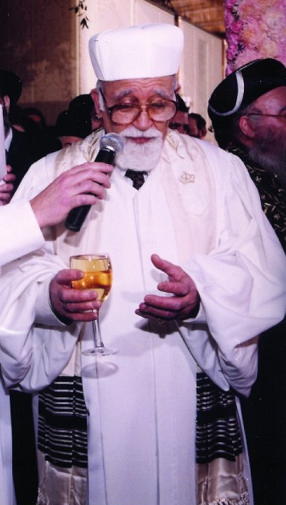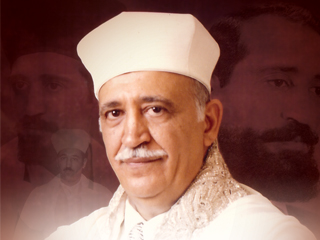

December 28, 2025 ~ Sh VAYHI. M HIJAZ.

 Raphael
Yair Elnadav was born in Jerusalem to a prominent Yemenite rabbinical
family that had immigrated to Jerusalem around the turn of the 20th
century. As a young man, Hakham
Raphael studied in Yeshivat Porat Yosef in Jerusalem’s Old City.
He studied hazzanut under the celebrated Sephardic Hazzan Yaakov
Levi. At the Conservatory Arzi
Israeli in Jerusalem, he received advanced training in voice development, in
violin and in theory and harmony of music. Under
the aegis of Professor Moshe Cordova, he mastered the many maqamat of
Oriental music. Simultaneously,
he continued his Torah learning in Jerusalem’s Yeshivat Shaare Zion under
Chief Rabbi Ben-Zion Uziel. He earned semicha
(rabbinical ordination) from Rabbi Eliezer Waldenberg
(1915-2006).
Raphael
Yair Elnadav was born in Jerusalem to a prominent Yemenite rabbinical
family that had immigrated to Jerusalem around the turn of the 20th
century. As a young man, Hakham
Raphael studied in Yeshivat Porat Yosef in Jerusalem’s Old City.
He studied hazzanut under the celebrated Sephardic Hazzan Yaakov
Levi. At the Conservatory Arzi
Israeli in Jerusalem, he received advanced training in voice development, in
violin and in theory and harmony of music. Under
the aegis of Professor Moshe Cordova, he mastered the many maqamat of
Oriental music. Simultaneously,
he continued his Torah learning in Jerusalem’s Yeshivat Shaare Zion under
Chief Rabbi Ben-Zion Uziel. He earned semicha
(rabbinical ordination) from Rabbi Eliezer Waldenberg
(1915-2006).
In 1950, Elnadav married Bertha (Batia) Hassoun, and they settled in Tel Aviv where he was appointed chief hazan in Congregation Ohel Moed, the main Sephardic synagogue of Tel Aviv. Their eldest son, Yosef, was born soon after. By then, he had earned widespread acclaim in the world of hazzanut as a talented innovator, composer and expert in Sephardic liturgy.
He was only 34, but tremendously accomplished – a shohet (ritual slaughterer), mohel, hazzan and rabbi – when the life-altering job offer came. An emissary from Cuba’s Sephardic community arrived in Israel, having been sent for the sole purpose of offering Rabbi Elnadav the leadership of the community. After months of negotiation and deliberation, in 1955 Elnadav agreed to take the position in Havana and served the Cuban community at every level – leading the prayers, performing marriages, funerals, answering halachic queries and supervising kashrut in Cuba, overseeing the shehita process twice a week.
When Congregation Shaare Zion on Ocean Parkway in Brooklyn was in its planning stages, Mr. Isaac Shalom a’h spoke to Rabbi Elnadav and expressed his hope that the young hazzan would consider a position in the Syrian community once the Shaare Zion building was complete. In 1959, together with his two children (the youngest, Esther, was born later, in America) and parents-in-law, he moved to New York and assumed the position of Chief Cantor, a post he held for 21 years until his retirement in 1980.
| Section | Pizmon | Page | Song | Commentary | Recordings | Application |
|---|---|---|---|---|---|---|
| Baqashot | 61 | 69 | ידיד נפש |
R Elnadav |
ממצרים | |
| Rast | 155.03 | 132a | אל חביב |  |
R. Elnadav R Elnadav |
|
| Rast | 155.04 | 132b | חי אל נאדר |
R. Elnadav |
||
| Rast | 167.01 | 144a | אנא יה חביבי |
R. Elnadav R Elnadav |
||
| 167.1 | 142l | דגלי תשא על הרי |
R. Elnadav |
|||
| Ajam | 254.5 | 204a | יום זה ישיר ירון |
R. Elnadav |
||
| Nahwand | 265 | 210 | אתה אל כביר |  |
R. Elnadav R Elnadav |
נשמת |
| Nahwand | 271 | 213 | אחזה בנועם |
R Elnadav |
פזמון | |
| Nahwand | 299.02 | 237b | החיש לצירך |
R. Elnadav R Elnadav |
||
| Nahwand | 299.06 | 237f | הדור שומע |
R. Elnadav |
||
| Bayat | 346 | 266 | אל מאד נעלה |
R. Elnadav |
שמחים | |
| Bayat | 391.05 | 318c | קולי שמעה |
R. Elnadav |
אל ההודאות | |
| Bayat | 391.06 | 318d | יקרך ישירו |  |
R. Elnadav |
|
| Hoseni | 430.01 | 353a | אל המרומם על כל ומתנשא |
R Elnadav |
||
| Sigah | 521 | 437 | יונה יקושה |
R. Elnadav |
||
| 742 | 353e | אפצחה פי בשירה וזמרה |
R Elnadav |
|||
| Berakhot | ברכות | 540 | השכבות |
R. Elnadav- Hashkava at Funeral of H Yaakob S Kassin, 1994 R. Elnadav- Hashkava at Funeral of H Matloub Abadi, 1970 |
||
| 2192 | 353c | גיל ורון |
R Elnadav |
|||
| Pentateuch | 3498.5 | P2 | הוצאת ספר תורה |
R Elnadav- Ashre Ha'Am |
||
| 4027 | 353b | אור צח קדוש ונעלם |
R Elnadav |
| Section | Pizmon | Page | Song | Commentary | Recordings | Application |
|---|---|---|---|---|---|---|
| Rast | 166 | 143 | רננות שיר ושבחה | Gindi Bar Misvah. |
I. Cabasso |
|
| Ajam | 254.5 | 204a | יום זה ישיר ירון | Bar Misvah of Morris Mickey Abraham. 1981. Photograph of Morris Abraham |
R. Elnadav |
|
| Nahwand | 299.04 | 237d | רוממו לו בקול | Composed for the Bar Misvah of Ezra Tawil to the melody of "Inta al-Hubb", a popular Arab song performed by Umm Kulthum. |
Arabic Recording Agudat Dodim (Buenos Aires)- Mimisrayim Moshe Dwek - Rau Banim |
|
| Nahwand | 299.06 | 237f | הדור שומע | Jack D. Hidary Bar Misvah. Photograph of Jack David Hidary |
J. Mosseri R. Elnadav |
|
| Nahwand | 299.1 | 237j | אל על שיר גיל נרון | Bar Misvah of Saul Ezra Ashkenazi. Composed by R Elnadav. 1984. |
M Habusha Recording Beth Torah: Haleluya I CABASSO QADDISH |
קדיש |
| 299.101 | באר ציון | Maqam Nahwand |
|
|||
| Nahwand | 299.102 | 237t | על הרי על הרי | Bar Misvah of Harry E Tawil. 1996. Composed by R Elnadav. Maqam Nahwand-Kurd |
M Habusha Recording I CABASSO QADDISH |
קדיש |
| Hoseni | 430.01 | 353a | אל המרומם על כל ומתנשא | Bar Misvah of Murray David Hidary (1984). |
R Elnadav |
|
| 742 | 353e | אפצחה פי בשירה וזמרה | Maqam Bayat Special pizmon to welcome Chief Rabbi of Israel, Maran Hakham Obadia Yosef, to the United States (1996). |
R Elnadav |
||
| Berakhot | ברכות | 540 | השכבות | Hashkabot are said for the deceased at the funeral. |
R. Elnadav- Hashkava at Funeral of H Yaakob S Kassin, 1994 R. Elnadav- Hashkava at Funeral of H Matloub Abadi, 1970 H Yaaqob Mizrahi, 1913- Tehiyat Hametim Prayer |
|
| 2192 | 353c | גיל ורון | Maqam Kourd Bar Misvah of Miro Isaac Sutton. Composed by H Raphael Y Elnadav. |
R Elnadav |